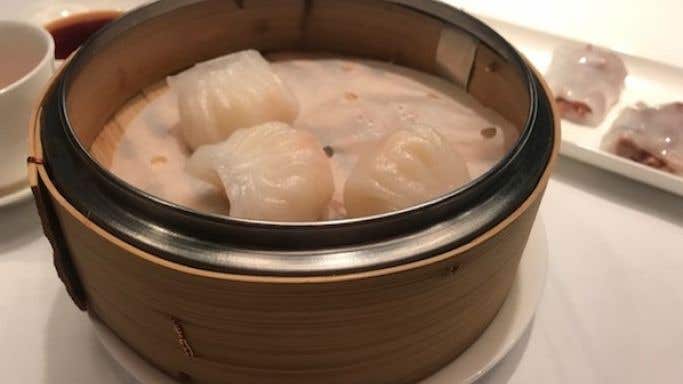As Chinese New Year (of The Pig) is celebrated, Nick investigates a high-profile newcomer in London. A version of this article is published in the Financial Times.
The news that the Imperial Treasure Group, which had hitherto opened restaurants in Singapore, Hong Kong and more than 20 other prominent cities across Asia, was planning to open in London, first circulated in the late spring of 2017.
I could not have been more excited. I have enjoyed everything this restaurant company has offered whenever I have eaten at one of their Asian outposts, and was thrilled that I would not now have to travel so far. Their new London home, on Waterloo Place at the bottom of Lower Regent Street, in what had been constructed in 1910 as an obviously imposing building, would present the new owners with an original set of challenges. But such is the dilemma facing every new entrant into this highly competitive city.
Imperial Treasure would also be opening in a part of the city that has grown increasingly competitive. This area, close to where Regent Street St James's meets Pall Mall was until five years ago devoid of good restaurants, but now Milos, the Greek fish restaurant, Le Balcon, the restaurant within the Sofitel hotel next door, and several more restaurants in nearby St James's Market such as Aquavit have filled this gap.
Imperial Treasure’s success has been based on serving exquisite Chinese food alongside some of the best wines of Europe, principally but not exclusively French and principally from Bordeaux. This is arguably less novel in London than it is in Asia, but would still resonate successfully if the interior designers had done their job properly and lent a glimmer of excitement to the building. Alas they have not.
There is nothing remotely sexy or appealing about the bar, a rather cold affair that has been added to the left of the entrance. The original interior has been largely effaced, allowing only glimpses of the ceiling and the cornices, as a far more modern interior has been inserted to break up what was once presumably a large banking hall into smaller units. There is no sign of the kitchen, nor of the chefs; the hustle and bustle of a Chinese kitchen is, unfortunately, not on view. As such it presents no rivalry to the bar at China Tang; the open kitchens at Hakkasan; the glamour on offer at Park Chinois; nor the views from the Min Jiang restaurant atop the Royal Garden Hotel.
The waiting staff are formally dressed in stiff white uniforms although there is, of course, the occasional Asian manager dressed in an open neck shirt and an expensive suit. There are tablecloths and the tables are well spaced.
Lighting, from overhead, is not particularly flattering but my principal criticism is reserved for the leather patterns on the banquettes. In the words of my Korean architect friend, they would be ‘more suitable for a pair of trainers'.
The menus too are dull and prosaic. The à la carte food menu is long, beginning with three set menus including a vegetarian one at £68 per person, before listing a whole range of fish and meat dishes. One category, headed Supreme Seafood, includes the endangered Japanese abalone and sea cucumber, which I know it is better for me to avoid as life is too short to unnecessarily provoke FT readers. Only the sight of the chef expertly carving the £100 Peking duck for a table of eight provided some form of visual excitement.
My conclusions from my lunch and dinner here were similar. That the food is good, sometimes very good, but that overall a sense of value is missing. Dinner for two cost £257.65 with no dessert or coffee but with four glasses of wine. And of these our two white wines, an Austrian Grüner Veltliner 2016 from Domäne Wachau and a 2015 Ramey Chardonnay from California, provided more freshness and zing to our food than either of the glasses of red wine.
The lobster bean curd roll was succulent, the bowl of lobster hot and cold soup full of lobster and probably staved off my impending cold. Of our two main courses, the stir-fried prawns with chilli and cashew nut was generous, unlike my two fillets of smoked and barbecued eel. The pak choi, at £16, was unjustifiably expensive, although less so than the baby broccoli at £18.
Today’s maxim on pricing is that restaurateurs can stretch the limits in the evening as long as there is a fair set-price menu at lunch, a lesson learnt at nearby Milos (£24 for three courses) and Le Balcon (£25 for the same). But, sadly, this fundamental lesson of London restaurant life has not yet been appreciated at Imperial Treasure.

A dim sum menu does offer this potential, say one from the fried section, one cheung fun and one from the grilled section for a fixed price, but all remain à la carte. This meant that my bill for six dim sum dishes with Puer tea came to £70.48 and perhaps accounted for the fact that there were only eight customers in the restaurant. Of these dim sum, the prawn cheung fun and the buttery venison puff were memorable.
The management of Imperial Treasure has a lot to learn about life in London. Fortunately, they signed a 25-year lease when they took over, so time is on their side.
Imperial Treasure Fine Chinese Cuisine 9 Waterloo Place, London SW1Y 4BE; tel +44 (0)20 3011 1328

